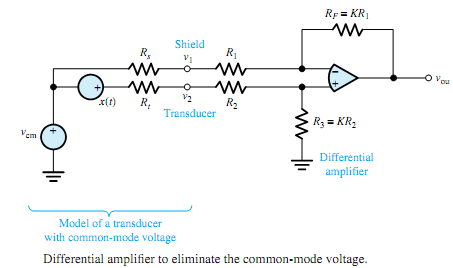Q. Differential amplifier to eliminate the common-mode voltage?
The transducer in some cases may have a local ground that cannot be disconnected. In such a case, a separate ground strap (braided-wire straps used because of their low inductance) is used to connect the local ground and the system ground point. The shield is also disconnected from the amplifier so as to prevent ground-loop current through the shield. Because the ground strap has nonzero resistance, any stray current through the strap will cause an interference voltage vcm known as common-mode voltage since it appears at both the transducer and the shield terminals.
vcm is generally quite small; however, when the information-bearing signal voltage itself is rather small, the common-mode voltage may pose a problem, which can be eliminated by using the differential amplifier, as shown in Figure. The analysis with the virtual-short model of the op-amp reveals that
vout = K(v2 - v1)
amplifying the difference voltage v2 -v1.With reasonable assumptions that Rs << R1 and Rt << R2, we have v1 ≅ vcm and v2 ≅ x + vcm, so that
vout = K [(x + vcm) - vcm] = Kx
in which vcm has been eliminated as desired. Such an op-amp circuit is also known as an instrumentation or transducer amplifier.
Any interference at frequencies outside the signal band can be eliminated by appropriate filtering. However, in order to combat interference within the signal band (after proper shielding and grounding), a notch filter is sometimes used to avoid the bothersome interference at a single frequency f0. Figure illustrates the point: Part (a) shows the composite amplitude spectrum including the single-frequency interference; part (b) depicts the amplitude ratio of the notch filter.
The notch-filtering technique does, of course, introduce some inevitable signal distortion, and such filtering should precede amplification to prevent possible saturation of the amplifier due to the interference.
